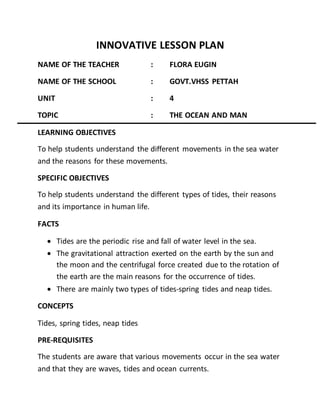
innovative lesson plan
- 1. INNOVATIVE LESSON PLAN NAME OF THE TEACHER : FLORA EUGIN NAME OF THE SCHOOL : GOVT.VHSS PETTAH UNIT : 4 TOPIC : THE OCEAN AND MAN LEARNING OBJECTIVES To help students understand the different movements in the sea water and the reasons for these movements. SPECIFIC OBJECTIVES To help students understand the different types of tides, their reasons and its importance in human life. FACTS Tides are the periodic rise and fall of water level in the sea. The gravitational attraction exerted on the earth by the sun and the moon and the centrifugal force created due to the rotation of the earth are the main reasons for the occurrence of tides. There are mainly two types of tides-spring tides and neap tides. CONCEPTS Tides, spring tides, neap tides PRE-REQUISITES The students are aware that various movements occur in the sea water and that they are waves, tides and ocean currents.
- 2. MATERIALS REQUIRED Videos, blackboard, chalk, social science textbook PROCESS SKILLS Observation skill and reasoning skill. CLASSROOM INTERACTION PROCEDURE RESPONSE The teacher creates a rapport with the students. Do you remember the movements of ocean water about which we learned in the previous class? The teacher asks we have learned that waves, types and ocean currents are the different movements in the sea water. We have also discussed about waves in detail. Today we are going to discuss about tides. Is the level of the sea at all hours in a day the same? The teacher asks. After hearing the student’s response, the teacher explains that the sea level is not the same at all hours and that the rice and fall of water level in the sea are called Tides. The teacher asks the students to state some of the main reasons for the occurrence of tides. Once the students response , the teacher explains that the main reason for the occurrence of tides are The gravitational attraction exerted on the earth by the sun and the moon Centrifugal force created due to the rotation of the earth. The teacher then asks students, can anybody explain as to what is meant by sidereal month and lunar month. After hearing the student’s response the teacher tells, the moon takes 27-32 days to go round the earth. This is known as sidereal month .But from one new moon to the next ,it takes 291/2 days .This is called a lunar month .Why are some days called a full moon day and new
- 3. moon day. Once the students responds the teacher explains new moon and full moon by making students understand the position of earth and moon in the above mentioned days. Activity The teacher randomly calls the numbers of three students and asks them to come forward. The teacher then names the three Earth, Moon and Sun. She asks students to stand in accordance to the positions as drawn in the Black Board. Earth Moon Sun: this is the position of the three in a new moon day. Moon Earth Sun: this is the position on the three in a full moon day. On full moon and new moon days the moon the earth and the sun come almost in a line. So the moon and the sun exert their combined gravitational pull on the earth. Hence the tides on these days are exceptionally powerful .They are called spring tides. The teacher asks another set of 3 students to come out and names them as earth moon and the sun .She then instructs them to take positions as shown in the blackboard. EARTH MOON SUN MOON EARTH SUN New Moon Full Moon
- 4. When the sun and moon attract the earth the earth at 90 degree angle the moon pulls the earth to one side the sun pulls the earth to the other side, which results in very low tides. They are called neap tides. The teacher concludes the class by explaining students as to how tides affect human life and also shows a video about ocean tides. SUNEARTH MOON EARTH MOON SUN
- 5. CONSOLIDATION Tides are the periodic rise and fall of water level in the sea. The gravitational attraction exerted on the earth by the sun and the moon and the centrifugal force exerted due to the rotation of the earth are the main reasons for the occurrence of tides. There are mainly two types of tides spring tides and neap tides. REVIEW QUESTIONS 1. What are tides? what are the different types of tides? 2. What are the reasons or the occurrence of tides?